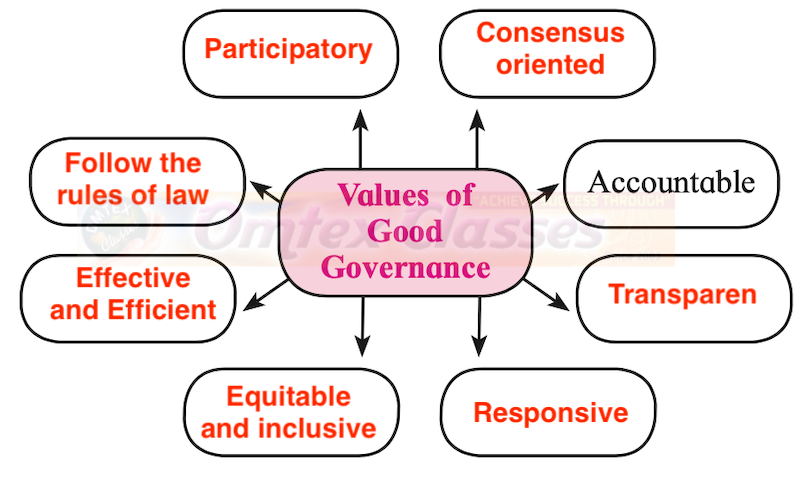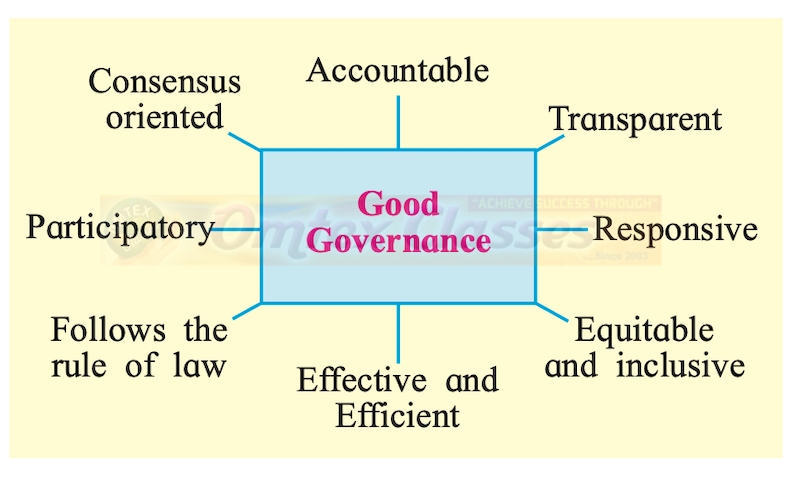Chapter 5: Contemporary India: Good Governance
Choose the correct option.
The concept of Lokpal is taken from
United States
United Kingdom
Sweden
Russia
The concept of ‘citizens charter’ is part of
POSDCORB
development administration
good governance
NGO activity
State the appropriate concept for the given concept.
The person investigating complaints against government officials -
Solution:
The person investigating complaints against government officials - Ombudsman
Compete for the concept map.
Solution:
State whether the following statement is true or false with reason.
Lokayukta can investigate complaints against political executives.
Options
True
False
Solution:
This statement is True.
(i) Lokayuktas were created by the Lokpal and Lokayuktas Act, 2013 to look into allegations of corruption against public functionaries in the States.
(ii) A member of the public can file specific allegations with the Lokayukta for inquiry against any public servant including legislators, political executives, local bodies, public enterprises.
Good Governance aims at the efficient use of natural resources.
Options
True
False
Solution:
This statement is True.
(i) One of the core values of good governance is effectiveness and efficiency.
(ii) It refers to sustainable human development in the context of efficient use of natural resources and the protection of the environment.
Explain the co-relation between the following.
Good Governance and E-Governance.
Solution:
Good Governance aims to replace traditional public administration riddled with corruption and red-tapism and to make it more citizen-centric, responsible, and responsive. The core values of good governance include efficiency, inclusiveness, being consensus-oriented, transparency, accountability, etc. Specific programs aimed at good governance include setting up of Lokpal and Lokayuktas, Creating of Citizen's Charters, Right to Information Act, institutional mechanisms like NHRC, NCW, etc. E-Governance is one of the most important aspects of good governance. It involves the employment of Information and Communications Technology (L.C.T) to facilitate efficient and instant transmission and processing of information as well as storing and retrieval of data. Thus, e-governance helps to implement core values of good governance such as transparency, effectiveness, accountability, and participation of citizens.
Express your opinion.
E-governance speeds up governmental processes.
Solution:
I agree with this statement.
E-governance refers to the use of Information and Communications Technology (I.C.T) to carry out the varied and complex aspects of governance and of citizens' expectations. E-governance facilitates instantaneous transmission and processing of information as well as efficient storing and retrieval of data. This helps in speeding up governmental processes and taking decisions expeditiously. Large scale digitisation of records enables easy and reliable access over the internet.
E-governance brought administration closer to people.
Solution:
I agree with this statement.
E-governance refers to the use of Information and Communications Technology (I.C.T) to carry out the varied and complex aspects of governance and of citizens' expectations. Large scale digitization of records enables easy and reliable access over the internet.
E-governance helps in increasing the geographical and demographical reach of the government. Efforts have been made at various levels to improve the delivery of public services and simplify the process of accessing them. The objective of the National e-Governance Plan is to bring public services closer to the people i.e., make them citizen-centric.
Answer the following.
Explain various institutions protecting the rights of different sections in India.
Solution:
The core values of good governance include administration being consensus-oriented based on principles of inclusiveness and equity as well as responsiveness to the needs of citizens.
The benefits of good governance must be available to all the sections of society. The constitution provides for socio-economic and political safeguards to certain disadvantaged sections of the society. Besides the safeguards, provided for them the government has created several commissions to safeguard the rights of different sections of the society.
These include the following:
(i) National Commission for Scheduled Castes:
Deals with matters related to the safeguards provided in the constitution for the Scheduled Castes and inquire into specific complaints relating to deprivation of rights of the Scheduled Castes.
(ii)National Commission for Scheduled Tribes:
Deals with matters related to the safeguards provided in the constitution for the Scheduled Tribes and inquire into specific complaints relating to deprivation of rights of the Scheduled Tribes.
(iii)National Human Rights Commission:
It deals with protection of rights relating to life, liberty, equality and dignity guaranteed by the constitution.
(iv) National Commission for Women:
This was created to facilitate the redressal of grievances and accelerate the socio-economic development of women.
(v)National Commission for the Protection of Child Rights:
It seeks to protect, promote, and defend child rights in the country. The Commission defines a child as a person in the 0 to 18 years of age group.
(vi) National Commission for Backward Classes: The focus is on the welfare of socially and economically backward classes.
(vii) National Commission for Minorities:
It monitors the working of the safeguards for minorities provided in the Constitution and by-laws enacted by the Parliament and the State Legislatures. The National Commission for Minorities recognizes the following religious communities as minority communities: Muslim, Sikh, Christian, Buddhist, Parsis, and Jain.
(viii) National Consumer Disputes Redressal Commission:
This provides for a consumer disputes redressal mechanism e.g., consumer courts are set up.
Answer the following question in detail with help of a given point.
Explain in detail the following values of Good Governance.
(a) participation
(b) transparency
(c) responsiveness
(d) accountability
Solution:
In development administration, not only the government but also citizens and NGO's play a vital role. The term 'governance' is used to describe this cooperative effort of the government and non-governmental bodies in public administration. Governance is broader than government as
(i) It includes formal institutions of government e.g., legislature, bureaucracy as well as informal institutions e.g., NGOs.
(ii) It aims to improve the performance of public institutions with a focus on values like accountability, transparency, citizen feedback, etc.
The Good Governance approach aims at the following -
(i) To reform the traditional, huge-sized public administration which was riddled with red tape and corruption.
(ii) To replace the archaic systems with responsible, participative, and equitable systems.
(iii) To look at interlinkages between government and civil society.
(iv) To make the administration citizen-centered and not rule-bound.


